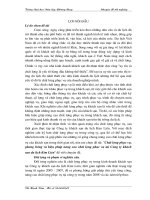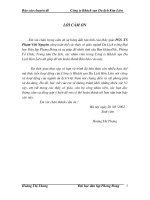Nâng cao chất lượng dịch vụ trong cung cấp dịch vụ tài khoản thanh toán cá nhân tại techcombank
Bạn đang xem bản rút gọn của tài liệu. Xem và tải ngay bản đầy đủ của tài liệu tại đây (434.9 KB, 9 trang )
Nâng cao chất lượng dịch vụ trong cung cấp
dịch vụ tài khoản thanh toán cá nhân tại
Techcombank
Phùng Thị Phương Thảo
Đại học Quốc gia Hà Nội
Ngành: Quản trị kinh doanh; Mã số: 60 34 05
Người hướng dẫn: TS. Trần Đoàn Kim
Năm bảo vệ: 2012
Abstract: Luận văn tập trung vào việc phân tích sâu nhóm khách hàng cá nhân
sử dụngtài khoản hiện tại, các yếu tố của sự hài lòng và đưa ra một số sáng
kiến cải thiện sự hài lòng của khách hàng.
Keywords: Quản trị kinh doanh; Tài khoản; Thanh toán cá nhân; Tài chính; Ngân
hang
Content
vi
TABLE OF CONTENTS
ACKNOWLEGEMENT i
ABSTRACT ii
TÓM TẮT iv
TABLE OF CONTENTS vi
LIST OF TABLES ix
LIST OF FIGURES xi
CHAPTER 1 LITERATURE REVIEW 1
1.1 CUSTOMER REALATIONSHIP MANAGEMENT 1
1.1.1 Definition 1
1.1.2 IDIC: Four implementation tasks for creating and managing customer
relationships. 2
1.2 CUSTOMER SATISFACTION 4
1.2.1. Definition 4
1.2.2. The role of expectations and perceptions 5
1.2.2. Service quality and GAP model 6
CHAPTER 2 TECHCOMBANK CASE STUDY 19
2.1 TECHCOMBANK AND CURRENT ACCOUNT SERVICES 19
2.1.1 Techcombank overview 19
2.1.2 Techcombank current account strategy and ambitious plan to 2014 26
2.1.2 Techcombank current account’s performance 28
2.2 A REVIEW OF TECHCOMBANK’S CUSTOMER RELATIONSHIP
MANAGEMENT 30
vii
2.2.1 CRM department 30
2.2.2 CRM in process 31
2.3 A REVIEW OF TECHCOMBANK’S SURVEY ON CURRENT
ACCOUNTS SERVICE 31
2.3.1 Survey objective 31
2.3.2 Focus group 33
2.3.3 Quantitative survey on customer satisfaction 36
2.3.4 Quantitative survey on customer satisfaction 43
CHAPTER 3: FINDINGS 45
3.1 CRM ACTIVITIES 45
3.2 CUSTOMER GAP ANALYSIS 46
3.3 PROVIDER GAP ANALYSIS 48
3.3.1 Not knowing what customers expect and not selecting the right service
designs and standards 48
3.3.2 Not delivering to service designs and standards and not matching
performance to promises 50
CHAPTER 4: RECOMMENTATION 56
4.1 INTERNAL TRANING AND COMMUNICATION 56
4.2 KPIs AND SALES ORIENTATION 57
4.3 ENHANCE SERVICE STANDARDZATION 58
4.4 IMPROVEMENT PROCEDURE TO REDUCE SERVING TIME 59
4.5 DEVELOP ALTERNATIVE CHANNEL TO REDUCE OTC WORKLOAD
60
4.6 PRODUCT DESIGN 60
viii
4.7 PAYROLL FORCUS 61
4.8 CRM ENHANCEMENT 63
QUESTIONNAIRE 65
REFERENCES 97
97
REFERENCES
Bachelet, D. (1995) “Measuring Satisfaction, or the Chain, the Tree
and the Nest” in Brooks, R.(Ed.) (1995) Customer Satisfaction
Research, Amsterdam, European Society for Opinion andMarketing
Research.
Bouckaert, G., Löffler, E. and Pollitt, C. (2006), Scientific report on
the 4
th
European Quality Conference, Finland: Tampere.
Cabinet Office (2006), Customer insight in public services: A
“Primer”, London.
Bovaird, T. & Löffler, E. (eds.) (2003). Public Management and
governance. London: Routledge.
Caddy J. & M. Vintar, Building Better Quality Administration for the
public: Case studies from Central and Eastern Europe. NISPAcee.
Communities Scotland (2006), How to gather views on service quality,
Scottish Executive.
Dinsdale, G. and Marsden, D. (1999), Citizen/Client Surveys:
Dispelling Myths and Redrawing Maps, for the Citizen centred
network, CCMD.
Doherty, L. and Horne, T. (2002) Managing public services.
Routledge, London.
Elam, G. and Ritchie, J. (1997), Exploring Customer Satisfaction,
Research Report No. 63, A report of research carried out by Social and
Community Planning Research on behalf of the Department of Social
Security.
Engel, C. (2002).”Common Assessment Framework: The state of
affairs”, Eipascope, (1).
98
EIPA (2006). CAF Works: Better results for the citizen by using CAF.
Maastricht: EIPA.
EIPA (2006), Common Assessment Framework: version 2006,
Maastricht.
EIPA (2007), Report on customer insight questionnaire, Prepared on
behalf of the Portuguese Presidency for the IPSG meeting 15-16
November 2007, Lisbon, p. 39.
Ferlie, E., Ashburne, L., Fitzferald, L. and Pettigrew, A. (1996) The
new public management in action. Oxford: Oxford University Press.
Flemish Government, 2007, Guideline for the creation of a client
satisfaction questionnaire.
Gaster, L. and Squires A. (2003) Providing quality in the public sector.
Maidenhead: Open University Press.
Hoffman K. & J. Bateson, (1997). Essentials for service marketing,
The Dryden Press, Chicago.
Johnston, R. and Heineke, J. (1998), Exploring the Relationship
Between Perceptions and Performance: Priorities for Action ,The
Services Industries Journal, Vol 18, Nº 1 (January).
Johnston, R. (1995), The determinants of service quality: satisfiers and
dissatisfiers, International Journal of Bank Marketing.
Kickert, W. (ed.) (1997) Public management and administrative reform
in Western Europe. Cheltenham: Edward Elgar.
Kettl, D. (2000) The global public management revolution: a report on
the transformation of governance, Washington, DC: The Brookings
Institution.
Lane, J.(2000) New public management. London, Routledge.
Löffler E. & M.Vintar (2004) , The current quality agenda of East and
99
West European public services, in Löffler E. & M. Vintar (eds.),
“Improving the quality of East and West European public services”,
Ashgate.
Löffler, E.(2002) “Defining and measuring quality in public
administration”, in: Caddy J. and M. Vintar (eds.) Building better
quality administration for the public, Slovakia, NISPACee.
Loffler, E,. Parrado, S., and Zmeskal, T., (2006), Improving customer
orientation through customer charters.
TCB, 1st half of 2012 retail report
TCB, 2011-2014 CA strategy
The Prime Minsters’ Office of Public Service Reform (2002), Public
Service Reform, MORI report for the Cabinet Office Satisfaction with
Public Services.
Oakland, J. (1995) Total Quality Management. The route to improving
performance, 2nd Edition, Butterworth Heinemann, Oxford.
OECD (1993), Public Management Developments, Survey 1993, Paris,
OECD
OECD (1995), Governance in transition. Public management reforms
in OECD countries, OECD, Paris.
OECD (1997), In search of results. Performance management
practices, Puma, Paris.
OECD (2000), Government of the Future, Puma, Paris.
OECD (2001a), Citizens as partners: information, consultation and
public participation in policy- making.
OECD (2001b) “Engaging Citizens in Policy-making: information,
consultation and public participation”. PUMA Policy Brief, No.10,
July 2001.
100
Parasuraman, A., Zeithaml, V.A. and Berry, L.L. (1985), “A
conceptual model of service quality and its implication”, Journal of
Marketing , Vol. 49, Fall.
Parasuraman, A., Zeithaml, V.A. and Berry, L.L. (1986),
“SERVQUAL: a multiple-item scale for measuring customer
perceptions of service quality”, Report No. 86-108, Marketing Science
Institute, Cambridge, MA.
Parasuraman, A., Zeithaml, V.A. and Berry, L.L. (1988),
“SERVQUAL: a multi-item scale for measuring consumer perceptions
of the service quality”, Journal of Retailing , Vol. 64, No. 1.
Parasuraman, A., Zeithaml, V.A. and Berry, L.L. (1991), “Refinement
and reassessment of the SERVQUAL scale”, Journal of Retailing , Vol.
67.
Peppers and Rogers, 2004
Peters, B.G. & D.J. Savoie (eds.) (2000), Governance in the twenty-
first century. Montreal:CCMD & McGill-Queen’s university press.
Pollitt C. and G. Bouckaert (eds.) (1995). Quality Improvement in
European Public Services, Concepts, Cases and Commentary. London:
Sage.
Pollitt C. and G. Bouckaert (2000). Public Management Reform: An
International Comparison. Oxford: Oxford University Press, 2000.
Accounts Commission for Scotland (1999), Can’t Get No Satisfaction:
Using a gap approach to measure service.
R&D department, PFS action 2013 plan
Ross J., Total Quality Management, 1999, St; Lucie Press, Boca Raton.
Schick, A. (2000) “Opportunity, Strategy and Tactics in Reforming
Public Management” in: OECD, Government of the Future.
101
Schmidt and Stricklan, (2000) Client Satisfaction Surveying: Common
Measurements Tool, Canadian Centre for Management Development
November 2000.
Shand, D. & Arnberg, M. (1996). Background paper; in: OECD;
Responsive Government. Service Quality Initiatives; Paris.
Staes, P., & Thijs, N. (2005). Quality Management on the European
Agenda. Eipascope, 2.
Thijs, N. & Staes, P. (2005). The Common Assessment Framework in
European Public Administrations. a state of affairs after five years.
Eipascope. 3.
Thijs, N. & Staes P. (2008) Applying the Common Assessment
Framework in Europe. In: de Lancer Julnes, P., Berry, F. and
Aristigueta, M. (Eds.) International handbook of practice based
performance management, Sage.






